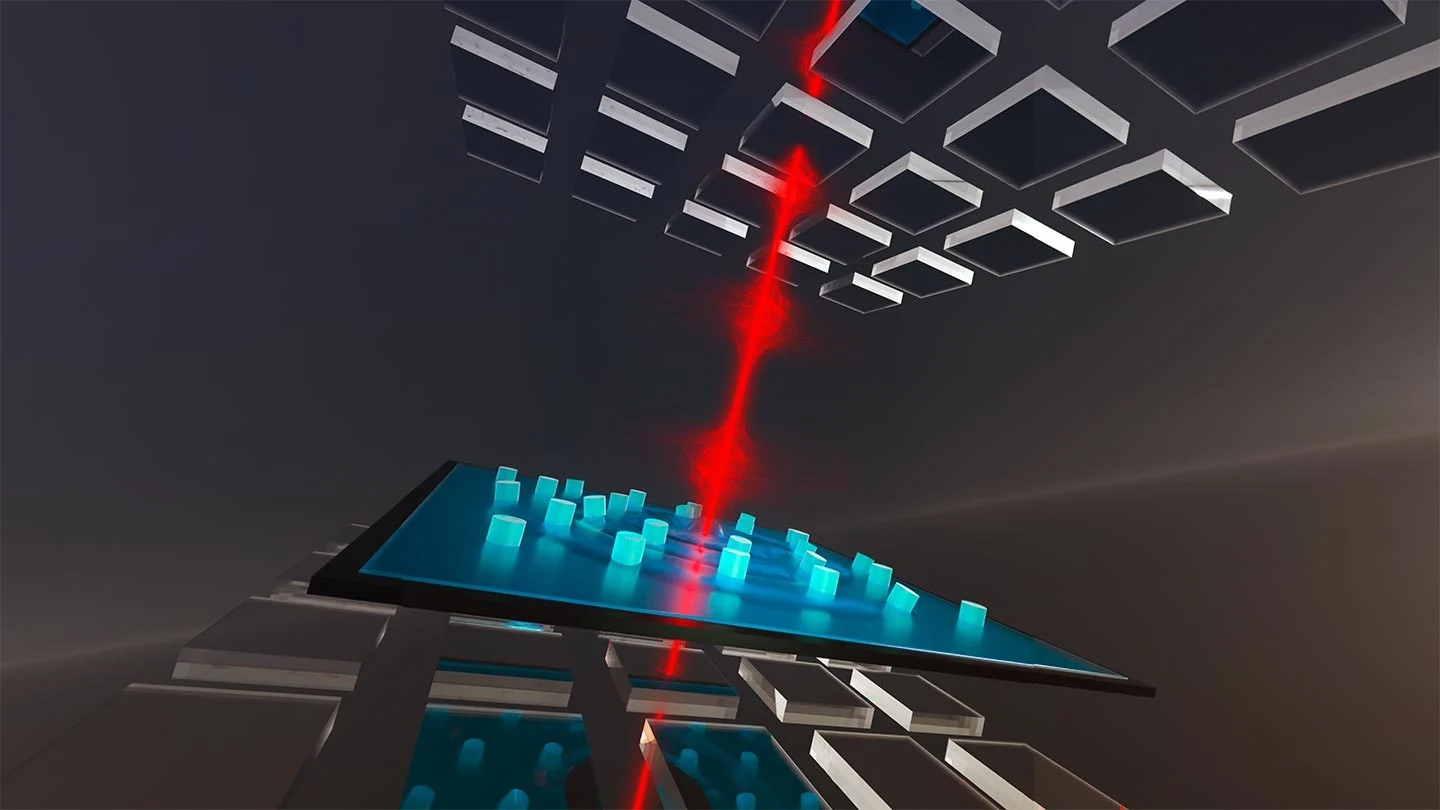博文
量子冰时代的终结:室温的突破
 精选
精选
||
量子冰时代的终结:室温的突破
诸平
Fig. 2 The crystal-like cavity mirrors with the drum in the middle. Credit: Guanhao Huang/EPFL
据瑞士洛桑联邦理工学院(école Polytechnique Fédérale de Lausanne简称EPFL)2024年2月14日提供的消息,EPFL的研究人员通过在室温下控制量子现象,克服了需要极冷的长期障碍,在量子力学方面取得了里程碑式的成就,这为量子技术的应用和宏观量子系统的研究开辟了新的可能性。具体介绍详见EPFL网站和《科技日报》(SciTechDaily)网站的相关报道:
EPFL网站:室温下的“量子飞跃”(A “quantum leap” at room temperature)
《科技日报》(SciTechDaily):量子冰时代的终结:室温的突破(The End of the Quantum Ice Age: Room Temperature Breakthrough)
在量子力学领域,在室温下观察和控制量子现象的能力长期以来一直难以捉摸,特别是在大尺度或宏观尺度上。传统上,这种观察仅限于接近绝对零度的环境,在此苛刻的环境下量子效应更容易被探测到。然而,对极端低温的要求一直是限制量子技术实际应用的主要障碍。
EPFL的开创性研究(Pioneering Study at EPFL)
现在,由EPFL的托比亚斯·基彭伯格(Tobias J. Kippenberg)和尼尔斯·约翰·恩格尔森(Nils Johan Engelsen)领导的一项研究重新定义了可能性的界限。这项开创性的工作将量子物理学和机械工程相结合,实现了室温下量子现象的控制。
托比亚斯·基彭伯格说:“几十年来,达到室温量子光力学一直是一个公开的挑战。我们的工作有效地实现了长期以来被认为只是一个理论玩具模型(theoretical toy model)的海森堡显微镜(Heisenberg microscope)。”相关研究结果于2024年2月14日已经在《自然》(Nature)杂志网站发表——Guanhao Huang, Alberto Beccari, Nils J. Engelsen, Tobias J. Kippenberg. Room-temperature quantum optomechanics using an ultralow noise cavity. Nature, 2024, 626: 512–516. DOI: 10.1038/s41586-023-06997-3. Published: 14 February 2024. https://www.nature.com/articles/s41586-023-06997-3
参与此项研究的除了来自EPFL的研究人员之外,还有来自瑞典查尔默斯理工大学(Chalmers University of Technology, Göteborg, Sweden)的研究人员。他们发表在《自然》杂志上的实验装置中,研究人员创造了一个超低噪音的光机械系统(ultra-low noise optomechanical system),在这个系统中,光和机械运动相互连接,使他们能够高精度地研究和操纵光如何影响运动物体。
室温的主要问题是热噪声,它会扰乱微妙的量子动力学。为了最大限度地减少这种影响,科学家们使用了腔镜(cavity mirrors),这是一种专门的镜子,可以在一个有限的空间(腔)内来回反射光线,有效地捕获光线,并增强其与系统中机械元件的相互作用。为了减少热噪声,腔镜被设计成晶体状的周期性(“声子晶体”,“phononic crystal”)结构。
创新实验设置(Innovative Experimental Setup)
另一个关键部件是一个直径4 mm的鼓状装置(drum-like device),称为机械振荡器(mechanical oscillator),它与腔内的光相互作用。其相对较大的尺寸和设计是将其与环境噪声隔离开来的关键,这使得在室温下探测微妙的量子现象成为可能。尼尔斯·约翰·恩格尔森说:“我们在这个实验中使用的鼓状装置是多年来努力创造与环境隔离良好的机械振荡器的高潮。”
“我们用来处理臭名昭著的复杂噪声源的技术对更广泛的精密传感和测量领域具有高度相关性和影响,”领导该项目的两名博士生之一黄冠豪(Guanhao Huang音译)说。
这种设置使研究人员能够实现“光压缩”(“optical squeezing”),这是一种量子现象,光的某些特性,如强度或相位,被操纵以减少一个变量的波动,而增加另一个变量的波动,正如海森堡原理所指示的那样。
通过在他们的系统中展示室温下的光压缩,研究人员表明他们可以在不需要极低温度的情况下有效地控制和观察宏观系统中的量子现象。该团队认为,在室温下操作系统的能力将扩大对量子光力学系统的访问,量子光力学系统是宏观尺度上量子测量和量子力学的测试平台。
另一位领导该研究的博士生阿尔贝托·贝卡里(Alberto Beccari)补充道:“我们开发的系统可能会促进新的混合量子系统,其中机械鼓与不同物体(如被困的原子云)强烈相互作用。这些系统对量子信息很有用,并帮助我们理解如何创建大型、复杂的量子态。”
本研究得到了瑞士国家科学基金会{ Swiss National Science Foundation under grant agreement no. 185870 (Ambizione) and grant agreement no. 204927 (Cavity Quantum Electro-optomechanics)}、欧洲研究理事会{European Research Council (ERC) under the EU H2020 research and innovation programme, grant agreement no. 835329 (ExCOM-cCEO)}的资助。
上述介绍,仅供参考。欲了解更多信息,敬请注意浏览原文或者相关报道。
At room temperature, mechanical motion driven by the quantum backaction of light has been observed only in pioneering experiments in which an optical restoring force controls the oscillator stiffness1,2. For solid-state mechanical resonators in which oscillations are controlled by the material rigidity, the observation of these effects has been hindered by low mechanical quality factors, optical cavity frequency fluctuations3, thermal intermodulation noise4,5 and photothermal instabilities. Here we overcome these challenges with a phononic-engineered membrane-in-the-middle system. By using phononic-crystal-patterned cavity mirrors, we reduce the cavity frequency noise by more than 700-fold. In this ultralow noise cavity, we insert a membrane resonator with high thermal conductance and a quality factor (Q) of 180 million, engineered using recently developed soft-clamping techniques6,7. These advances enable the operation of the system within a factor of 2.5 of the Heisenberg limit for displacement sensing8, leading to the squeezing of the probe laser by 1.09(1) dB below the vacuum fluctuations. Moreover, the long thermal decoherence time of the membrane oscillator (30 vibrational periods) enables us to prepare conditional displaced thermal states of motion with an occupation of 0.97(2) phonons using a multimode Kalman filter. Our work extends the quantum control of solid-state macroscopic oscillators to room temperature.
https://wap.sciencenet.cn/blog-212210-1421865.html
上一篇:单光子集成的突破为量子计算、密码学带来了希望
下一篇:蝴蝶翅膀激发催化剂设计的突破

